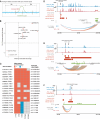Genetic coupling of enhancer activity and connectivity in gene expression control
- PMID: 39870618
- PMCID: PMC11772589
- DOI: 10.1038/s41467-025-55900-3
Genetic coupling of enhancer activity and connectivity in gene expression control
Abstract
Gene enhancers often form long-range contacts with promoters, but it remains unclear if the activity of enhancers and their chromosomal contacts are mediated by the same DNA sequences and recruited factors. Here, we study the effects of expression quantitative trait loci (eQTLs) on enhancer activity and promoter contacts in primary monocytes isolated from 34 male individuals. Using eQTL-Capture Hi-C and a Bayesian approach considering both intra- and inter-individual variation, we initially detect 19 eQTLs associated with enhancer-eGene promoter contacts, most of which also associate with enhancer accessibility and activity. Capitalising on these shared effects, we devise a multi-modality Bayesian strategy, identifying 629 "trimodal QTLs" jointly associated with enhancer accessibility, eGene promoter contact, and gene expression. Causal mediation analysis and CRISPR interference reveal causal relationships between these three modalities. Many detected QTLs overlap disease susceptibility loci and influence the predicted binding of myeloid transcription factors, including SPI1, GABPB and STAT3. Additionally, a variant associated with PCK2 promoter contact directly disrupts a CTCF binding motif and impacts promoter insulation from downstream enhancers. Jointly, our findings suggest an inherent genetic coupling of enhancer activity and connectivity in gene expression control relevant to human disease and highlight the regulatory role of genetically determined chromatin boundaries.
© 2025. Crown.
Conflict of interest statement
Competing interests: M.S. is a shareholder of Enhanc3D Genomics Ltd. C.W. is supported by GSK and MSD and is a part-time employee of GSK. GSK had no role in this study or the decision to publish. The remaining authors declare no competing interests.
Figures








Similar articles
-
High-resolution genome topology of human retina uncovers super enhancer-promoter interactions at tissue-specific and multifactorial disease loci.Nat Commun. 2022 Oct 7;13(1):5827. doi: 10.1038/s41467-022-33427-1. Nat Commun. 2022. PMID: 36207300 Free PMC article.
-
Enhancer release and retargeting activates disease-susceptibility genes.Nature. 2021 Jul;595(7869):735-740. doi: 10.1038/s41586-021-03577-1. Epub 2021 May 26. Nature. 2021. PMID: 34040254 Free PMC article.
-
Enhancer variants associated with Alzheimer's disease affect gene expression via chromatin looping.BMC Med Genomics. 2019 Sep 9;12(1):128. doi: 10.1186/s12920-019-0574-8. BMC Med Genomics. 2019. PMID: 31500627 Free PMC article.
-
Coming full circle: On the origin and evolution of the looping model for enhancer-promoter communication.J Biol Chem. 2022 Aug;298(8):102117. doi: 10.1016/j.jbc.2022.102117. Epub 2022 Jun 9. J Biol Chem. 2022. PMID: 35691341 Free PMC article. Review.
-
CTCF shapes chromatin structure and gene expression in health and disease.EMBO Rep. 2022 Sep 5;23(9):e55146. doi: 10.15252/embr.202255146. Epub 2022 Aug 22. EMBO Rep. 2022. PMID: 35993175 Free PMC article. Review.
References
-
- Claringbould, A. & Zaugg, J. B. Enhancers in disease: molecular basis and emerging treatment strategies. Trends Mol. Med.27, 1060–1073 (2021). - PubMed
MeSH terms
Substances
Grants and funding
LinkOut - more resources
Full Text Sources
Miscellaneous

